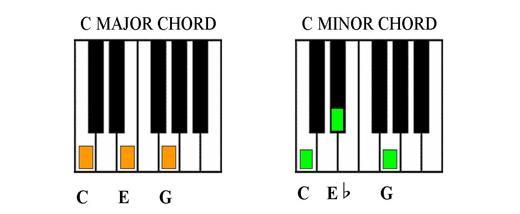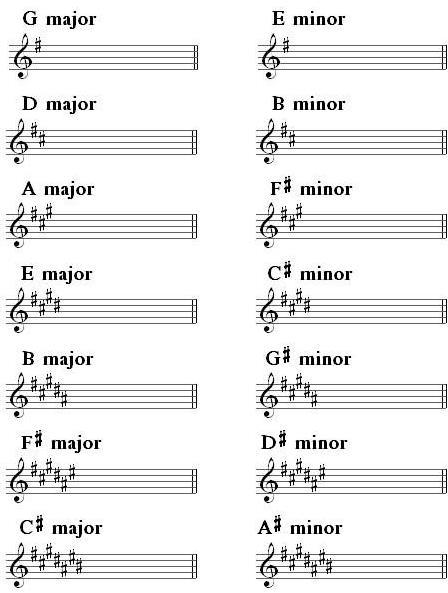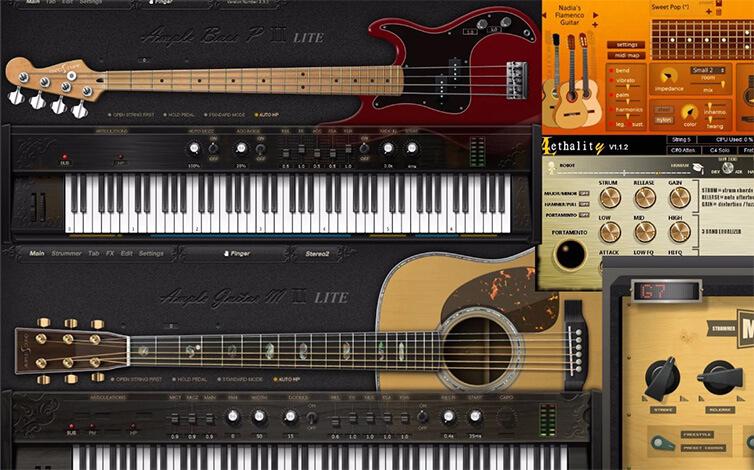What is harmony in music

These elements of harmony are in close interaction. A melody is perceived as harmonious when it is created in accordance with certain rules for the combination of sounds. In order to master these rules, it is necessary to become familiar with the basic concepts of harmony, that is, with categories that are to one degree or another related to the concept of “harmony”.
Intervals
The fundamental unit of harmony is the interval, which is defined as the difference in semitones between two musical notes. We have already encountered the concept of halftones in previous lessons, so no particular difficulties in understanding are expected.
Varieties of simple intervals:
- Prima – 0 semitones or unison;
- Minor second – 1 semitone;
- Major second – 2 semitones;
- Minor third – 3 semitones;
- Major third – 4 semitones;
- A perfect fourth – 5 semitones;
- Augmented fourth – 6 semitones or tritone (3 tones);
- Diminished fifth – 6 semitones or tritone (3 tones);
- Perfect fifth – 7 semitones;
- Minor sixth – 8 semitones;
- Major sixth – 9 semitones;
- Minor seventh – 10 semitones;
- Major seventh
- Major seventh – 11 semitones;
- Octave – 12 semitones.
Thus, simple intervals mean differences in the sound of notes that are within the same octave. Intervals larger than an octave are called compound intervals.
Types of compound intervals:
- Minor none – minor second + octave = 13 semitones;
- Major none – major second + octave = 14 semitones;
- Minor decima – minor third + octave = 15 semitones;
- Major decima – major third + octave = 16 semitones;
- Pure undecima – pure fourth + octave = 17 semitones;
- Augmented undecima – augmented fourth + octave = 18 semitones;
- Diminished duodecima – diminished fifth + octave = 18 semitones;
- Pure duodecima – pure fifth + octave = 19 semitones;
- Minor third decimal – minor sixth + octave = 20 semitones;
- Major tercidecima – major sixth + octave = 21 semitones;
- Minor quartdecima – minor seventh + octave = 22 semitones;
- Major quartdecima – major seventh + octave = 23 semitones;
- Quintdecima – 2 octaves = 24 semitones.
The first and main question: how to remember this? It’s actually not that difficult.
How and why to remember intervals
Learning and reproducing different intervals, as well as their names, is important for music education. You can start from any key, since in this context the choice of starting note is not critical. The main thing is to accurately determine the number of semitones between notes. For example, repeating the same key creates an interval of 0 semitones, while playing two adjacent keys creates an interval of 1 semitone, and so on. In the learning app, you can customize the number of keys on the screen for convenience.
Knowing intervals is important not only for theoretical knowledge, but also for practical application. Mastering this skill will allow you to easily select melodies by ear for both voice and instrumental performance. This is the main reason why many people start learning to play musical instruments such as guitar, violin, piano or drums.
Also, knowing the names of intervals will make it easier for you to understand pieces of music that are based on certain chords, as is often found in rock music. For example, knowing that a perfect fifth is 7 semitones, you can easily identify and play fifth chords when listening to bass lines, since they usually sound clearer, which is especially important for beginners.
To develop an ear for music, it is important to try to determine the fundamental tone (tonic) of a piece of music. You can do this using a learning app or a real instrument, playing the notes in search of unison with the root of the composition. Consistently pressing keys within an octave or playing notes on a guitar will help determine the tonic by unison.
Additional methods for developing musical ear will be discussed in subsequent lessons. At the moment, our main task is to visualize for you the concept of interval in music. Intervals can also be indicated by degrees, where only the main degrees of the scale are taken into account, not including sharps and flats, which is especially useful for pianists because of the clarity of the location of the white keys. However, for most other musicians it is more convenient to count intervals in semitones, since there is no visual separation of scale steps on instruments.

By the way, the word “harmony” has many meanings and is directly related to the topic of harmony.
Modes
The second key element of harmony is mode, the concept of which has evolved throughout the history of music theory. Different eras offered their own interpretations of the mode: as a system of combining notes, organizing their interactions, or a hierarchy of sound pitches. Modern understanding tends to define a mode as a structure of musical relationships centered around a specific note or harmony.
To simplify, we can, similar to relationships in life, imagine that harmony in music means a harmonious combination of sounds, just as some families say that they live in harmony.
In context of use, the term “mode” is often applied to concepts such as minor and major. “Minor”, derived from the Latin mollis (“soft”, “gentle”), is associated with lyrical or sad musical works. While “major”, coming from the Latin major (“large”, “important”), is often associated with more energetic and optimistic compositions.
Thus, minor and major modes are the main types of modes, and the features of each can be visualized by highlighting those steps (notes) that distinguish minor from major:

In everyday perception, a simple division of minor into “sad” and major into “joyful” is often encountered. However, this is quite arbitrary and does not always correspond to reality. A minor composition will not necessarily sound sad, just as a major composition does not always mean joy. This observation has been true since at least the 18th century. For example, Mozart’s “Sonata No. 16 in C Major” has moments of anxiety, while the famous children’s song about the grasshopper is written in a minor key.
Both minor and major begin with the tonic, which serves as the basis of the scale. This is followed by an alternation of stable and unstable sounds, characteristic of each mode. This can be compared to the process of building a wall, where both bricks and mortar are needed to achieve the desired strength and structure.
Later on you will come across the term “chord”. To avoid confusion, it is worth noting that stable scale degrees and fundamental chord degrees are different concepts. For beginning musicians, it is recommended to use ready-made chord fingerings, the principles of which will become clearer as you learn playing techniques and master simple melodies.
Also in special musical literature you can find references to modes such as Ionian, Dorian, Phrygian, Lydian, Mixolydian, Aeolian and Locrian. These modes are formed on the basis of the major scale, where the tonic is selected from one of its degrees. They are also called natural, diatonic or Greek modes.

Now let’s move on to discussing the concepts of major and minor, which are most often used in musical practice. The terms “major mode” and “minor mode” usually indicate specific modes within a harmonic key. Let’s look at the definitions of tonality in a general sense and harmonic tonality in particular.
Tonality
So, what is the concept of tonality? As with many terms in music, there are many definitions of tonality. The word “tonality” comes from the Latin “tonus”, which in the context of anatomy and physiology means long-term tension and activity of the nervous system, without leading to fatigue.
The phrase “stay on your toes” is well known outside of a musical context, and in music the meaning of this expression can be interpreted similarly. Melody and harmony are in a certain “musical tone” throughout the entire work.
As mentioned, every mode, whether minor or major, comes from the tonic. Both minor and major modes can be built from any chosen note that serves as the base, or tonic, of the composition. The relative height of a fret in relation to its tonic determines tonality. Therefore, the concept of tonality can be described through a simple formula.
Tonality formula:
Key = tonic + mode
That is why the definition of tonality is often given as the principle of mode, the main category of which is the tonic. Now let’s summarize.
Main types of tones:
- Minor;
- Major.
How to interpret this tonal formula and its variations in reality? Let’s imagine that we are listening to a piece of music in a minor key, based on the note “A”. This means that the piece is performed in the key of A minor (Am). It is important to note that minor keys are indicated by adding an “m” to the tonic. Thus, the symbol Cm indicates “C minor,” Dm indicates “D minor,” Em indicates “E minor,” and so on.
When a key notation uses capital letters to represent individual notes—C, D, E, F, and others—it indicates a major key. Thus, a piece in C, D, E, F will be in the keys of C major, D major, E major, F major, respectively.
Tonalities modified in relation to the basic degree of the scale are indicated using sharp and flat signs. Thus, F♯m or G♯m indicates “F sharp minor” or “G sharp minor.” On the other hand, notations with a flat, like A♭m (A-flat minor) or B♭m (B-flat minor), indicate lowered keys.
In major keys, sharp or flat signs are placed next to the tonic without additional symbols. Examples include C♯ (C sharp major), D♯ (D sharp major), A♭ (A flat major), B♭ (B flat major). There are also more detailed key designations, where the indication major or minor is used, and the words sharp or flat replace the signs of sharp and flat.
Other methods of recording tones, less commonly used in daily practice, will not be discussed in detail here, but can be presented in the form of illustrative materials for your reference.
These are options for representing minor and major keys:

All the types of keys mentioned form the basis for harmony in music, i.e. they determine the harmonic background of the work.
Thus, harmonic tonality is a system based on the major and minor principles of tonal harmony.
In addition, there are other forms of tonality. Let’s take a closer look at them:
- Keys of the same name are based on the same tonic, but belong to different modes, for example, “F minor” and “F major”;
- Parallel keys differ by the interval of a minor third (3 semitones) between the tonics of minor and major, for example, “A minor” and “C major”, “G sharp minor” and “B flat major”;
- One-third keys have a common third and differ by a minor second (1 semitone), for example, “C major” and “C sharp minor” with a common third “E”.
Scales
In order to easily master the concept of scale, you need to have a clear understanding of what mode and tonality are. You can learn about a more detailed analysis of these topics from previous articles, which are recommended to be read for a better understanding :))
Five short and clear articles will help you with this.
Briefly about modes and keys:
- Scale is a method of ordering notes. There are many such methods (modes), but for the last 400 years the most popular have been major and minor, organized around the root note. Both modes have 7 steps (notes of different pitches);
- Gamma is formed when the notes of a major or minor scale are arranged in ascending or descending order from tonic to tonic within one or more octaves. Thus, a scale is a sequence of all the notes of a scale. In other words, these are the notes of a scale played sequentially up and down over any number of octaves;
- Tonality determines whether a major or minor key is pitched. This means choosing a specific note for the first degree, from which the remaining degrees of major or minor are then built. For example, the name “G major” indicates a key where the major begins with the tonic on the note G. More detailed information on this topic is contained in a separate article, so we will not go deeper here.
How does a scale differ from a scale?
A scale is a series of sounds ordered by pitch, either ascending or descending. Gamma is a specific type of scale, which is built within a certain mode, as opposed to a simple list of sounds arranged in height. Therefore, although these terms seem similar, they have differences. The scale can be performed in any order and contain any number of notes – from three or more. While the execution of a scale involves the presence of only those sounds that belong to a certain mode, and it is performed from the initial tonic to the final, including a minimum of 8 steps.
Practice playing different examples of scales and scales to discover for yourself the similarities and differences between scales and scales.
Why play scales?
- Firstly, regular practice of scales contributes to the development of playing technique, improves flexibility and speed of finger movement. Scales and scale-like passages are often found in pieces of music, especially when you need to perform fast passages that run through a sequence of notes in the scale. Mastering scales greatly facilitates the study of such musical fragments, reducing the time required to master them;
- Second, practicing scales improves a musician’s ability to navigate a variety of keys and quickly find the appropriate notes. Few pieces of music are limited to just using white keys, as is the case with C major. In fact, most compositions include many other keys that require strong mastery of both the white and black keys.










